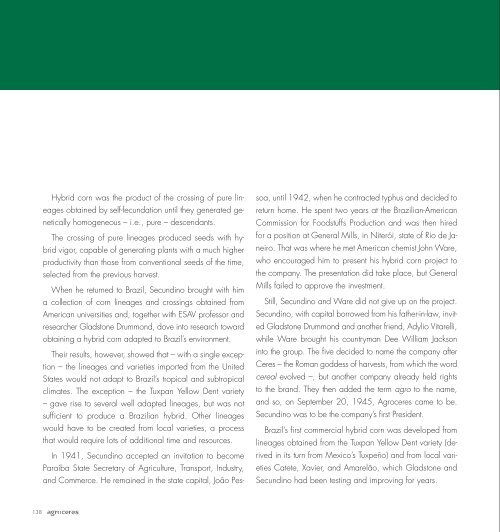Livro Agroceres
- No tags were found...
Create successful ePaper yourself
Turn your PDF publications into a flip-book with our unique Google optimized e-Paper software.
Hybrid corn was the product of the crossing of pure lin-<br />
soa, until 1942, when he contracted typhus and decided to<br />
Production began on the 65-hectare São Fernando farm,<br />
to devote himself entirely to <strong>Agroceres</strong>. The capital needed to<br />
eages obtained by self-fecundation until they generated ge-<br />
return home. He spent two years at the Brazilian-American<br />
which they purchased in Goianá, a district of Rio Novo,<br />
make the company grow came from an unexpected source.<br />
netically homogeneous – i.e., pure – descendants.<br />
The crossing of pure lineages produced seeds with hybrid<br />
vigor, capable of generating plants with a much higher<br />
productivity than those from conventional seeds of the time,<br />
selected from the previous harvest.<br />
When he returned to Brazil, Secundino brought with him<br />
a collection of corn lineages and crossings obtained from<br />
American universities and, together with ESAV professor and<br />
researcher Gladstone Drummond, dove into research toward<br />
Commission for Foodstuffs Production and was then hired<br />
for a position at General Mills, in Niterói, state of Rio de Janeiro.<br />
That was where he met American chemist John Ware,<br />
who encouraged him to present his hybrid corn project to<br />
the company. The presentation did take place, but General<br />
Mills failed to approve the investment.<br />
Still, Secundino and Ware did not give up on the project.<br />
Secundino, with capital borrowed from his father-in-law, invited<br />
Gladstone Drummond and another friend, Adylio Vitarelli,<br />
Minas Gerais. In its first year, the company produced and<br />
sold 3,000 kg of seeds packaged into bags that Secundino’s<br />
wife, Memorina, stitched together on her sewing machine.<br />
Secundino’s daughter Nice tells of the celebrations of<br />
<strong>Agroceres</strong>’s first anniversary: “The ‘party’ coincided with the<br />
christening of Neyde [Secundino’s youngest daughter], and<br />
only the family and Adylio Vitarelli were present. On top of<br />
the cake lay a beautiful ear of corn, pierced and plugged<br />
with a candle that Secundino and Adylio blew out.”<br />
In 1946, Nelson Rockefeller, one of the heirs of the Rockefeller<br />
companies and a future US Vice President, heard from<br />
Dee Jackson reports on the creation of a seeds company in<br />
Brazil. Rockefeller took a keen interest in <strong>Agroceres</strong>, since<br />
he had recently formed the International Basic Economy<br />
Corporation (IBEC), an agricultural arm of the Rockefeller<br />
Foundation whose purpose was to demonstrate the benefits<br />
of capitalism as an agent for economic and social development.<br />
A seeds company in a developing country such as<br />
obtaining a hybrid corn adapted to Brazil’s environment.<br />
while Ware brought his countryman Dee William Jackson<br />
To make sales, Secundino would go out on his Jeep and<br />
Brazil was a perfect match for Rockefeller’s plans, and, in<br />
Their results, however, showed that – with a single exception<br />
– the lineages and varieties imported from the United<br />
States would not adapt to Brazil’s tropical and subtropical<br />
climates. The exception – the Tuxpan Yellow Dent variety<br />
– gave rise to several well adapted lineages, but was not<br />
sufficient to produce a Brazilian hybrid. Other lineages<br />
would have to be created from local varieties, a process<br />
that would require lots of additional time and resources.<br />
into the group. The five decided to name the company after<br />
Ceres – the Roman goddess of harvests, from which the word<br />
cereal evolved –, but another company already held rights<br />
to the brand. They then added the term agro to the name,<br />
and so, on September 20, 1945, <strong>Agroceres</strong> came to be.<br />
Secundino was to be the company’s first President.<br />
Brazil’s first commercial hybrid corn was developed from<br />
lineages obtained from the Tuxpan Yellow Dent variety (de-<br />
talk the local farmers that, by planting his seeds, they would<br />
achieve harvests 20 to 30 percent greater than from seeds<br />
selected from their silos. In fact, he knew that productivity<br />
would be even greater and that the happy farmers would<br />
buy more for the next sowing. The miracle corn’s reputation<br />
quickly spread across the region.<br />
Secundino had made his dream of becoming a businessman<br />
come true, but profits would still take a long time to come<br />
1947, he sought out Secundino to propose an association.<br />
IBEC would hold a controlling stake and provide the majority<br />
of the equity for <strong>Agroceres</strong>, but management was to be<br />
the responsibility of the Brazilian partners.<br />
Antonio Pedro Total, in his book O Amigo Americano<br />
(“The American Friend”), on the billionaire’s initiatives in<br />
Brazil, tells of the creation of IBEC and Rockefeller’s association<br />
with Secundino. “In October 1950, back in New<br />
In 1941, Secundino accepted an invitation to become<br />
rived in its turn from Mexico’s Tuxpeño) and from local vari-<br />
and capital for growth was limited. In December 1947, he<br />
York, Nelson wrote to Secundino to report his impression<br />
Paraíba State Secretary of Agriculture, Transport, Industry,<br />
eties Catete, Xavier, and Amarelão, which Gladstone and<br />
accepted an invitation to become the Dean of ESAV, a posi-<br />
of a visit to the town of Jacarezinho, state of Paraná. He<br />
and Commerce. He remained in the state capital, João Pes-<br />
Secundino had been testing and improving for years.<br />
tion he retained until January 1951, when he was finally able<br />
calls the Brazilian ‘Dear Tony’, Americanizing his given<br />
138<br />
139


